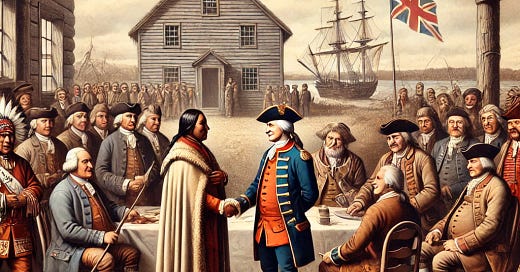The 1752 Treaty of Peace and Friendship
Introduction
The 1752 Treaty of Peace and Friendship was another agreement between the British Crown and the Mi’kmaq Nation. Signed on November 22, 1752, between Governor Peregrine Hopson and Mi’kmaq Chief Jean-Baptiste Cope, this treaty reaffirmed earlier peace agreements and introduced new provisions, including trade rights and protections for Mi’kmaq hunting and fishing. Like previous Peace and Friendship treaties, this agreement did not involve land cession but was meant to establish diplomatic relations and secure peace.
Historical Context
During the mid-18th century, conflicts between the British and the Mi’kmaq escalated due to increasing British settlement in Nova Scotia. The Mi’kmaq resisted colonial expansion and viewed British military presence as a threat to their sovereignty. In an effort to establish peace and secure economic relations, Chief Jean-Baptiste Cope negotiated this treaty with the British, hoping to ensure fair trade and protection of Mi’kmaq ways of life.
Full Text of the Treaty (1752)
We, the undersigned, being delegated by our respective tribes and instructed therein, do agree, acknowledge, and declare as follows:
That all hostilities between the Mi’kmaq and His Majesty’s subjects shall cease immediately.
That the Mi’kmaq shall have free liberty to hunt and fish as usual and shall not be hindered by the British in any of their traditional practices.
That His Majesty’s government shall provide equal and fair trade with the Mi’kmaq at designated trading posts.
That no British subject shall molest or disturb the Mi’kmaq in their trade, hunting, fishing, or land use.
That the British shall establish a truckhouse (trading post) where the Mi’kmaq may trade freely and fairly.
That any disputes between British settlers and the Mi’kmaq shall be settled through fair negotiations.
That this treaty shall be binding on both parties, and its terms shall be upheld in good faith.
In witness whereof, we have set our marks and seals in the presence of witnesses, this twenty-second day of November, in the Year of Our Lord 1752.
Key Takeaways
This treaty did not cede land but reaffirmed Mi’kmaq rights to hunt, fish, and trade freely.
It established a designated trading post (truckhouse system) to ensure fair trade between the Mi’kmaq and British settlers.
The British promised non-interference in Mi’kmaq territory and traditional practices.
The treaty reflected Mi’kmaq efforts to secure economic stability and maintain their way of life while coexisting with British settlers.
Did This Treaty Hold?
The British failed to uphold many of their promises, leading to continued tensions and conflicts.
The truckhouse system was not maintained, undermining Mi’kmaq economic security.
Despite breaches, the Mi’kmaq continued to reference this treaty as a legally binding agreement in disputes over rights and land use.
Lasting Impact
This treaty is still recognized in modern court cases, particularly concerning Mi’kmaq hunting and fishing rights.
The Supreme Court of Canada has reaffirmed that Mi’kmaq rights under this treaty remain valid today.
The treaty plays a role in contemporary land and resource disputes, with Mi’kmaq leaders citing it as proof of their continued sovereignty.
Next in the Series
The next post will cover the 1760–1761 Peace and Friendship Treaties, which expanded British-Mi’kmaq relations and introduced new provisions for governance and trade.
This document provides a historical and legal reference for those exploring the early foundations of Mi’kmaq-Crown relations in Canada.






Just as the French are still considered a "distinct culture" on these lands, so should be the Original Peoples of Turtle Island. The Original Peoples of Turtle Island (first law of the land) prior to the European invasion have always had deep spiritual and cultural ties to the land, air, water, and viewed all of nature as interconnected and sacred. Who, or what culture could possibly disagree with this?
There are always voids left to skewer what we would believe to be a great humanitarian gesture.
Check out The CANADIAN ILLUSION ON YOU TUBE.